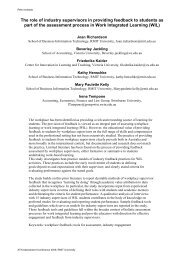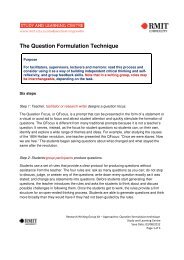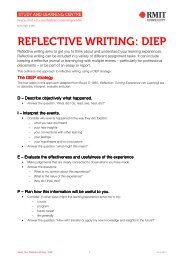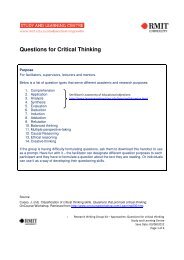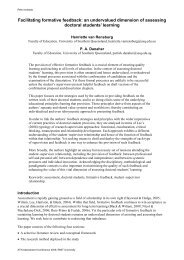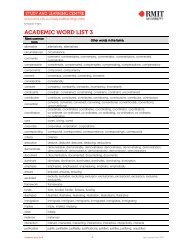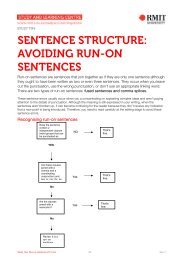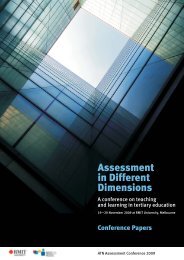student feedback and leadership - Office for Learning and Teaching
student feedback and leadership - Office for Learning and Teaching
student feedback and leadership - Office for Learning and Teaching
You also want an ePaper? Increase the reach of your titles
YUMPU automatically turns print PDFs into web optimized ePapers that Google loves.
Student Feedback & Leadership<br />
School increase in the Good <strong>Teaching</strong> Scale (GTS) of 12% <strong>for</strong> Semester 1<br />
2007 compared with 2006. While it was recognised that more longitudinal data<br />
is required be<strong>for</strong>e a cause <strong>and</strong> effect conclusion can be certain, this positive<br />
result had encouraged staff to take an interest in further improving their<br />
teaching practice.<br />
Challenges identified <strong>for</strong> the individual academic included; how to design<br />
appropriate learning <strong>and</strong> teaching practice to accommodate the discipline<br />
diversity of the <strong>student</strong>s. In addition the question of how to respond to<br />
<strong>student</strong> <strong>feedback</strong> that lecturers need to be enthusiastic <strong>and</strong> knowledgable<br />
was discussed.<br />
The School of Property, Construction <strong>and</strong> Project Management, ART<br />
identified the importance of two issues, the learning <strong>and</strong> teaching space<br />
available <strong>for</strong> teaching <strong>and</strong> the teaching experience of staff. Using their<br />
discipline expertise (building <strong>and</strong> construction) they were developing<br />
a ‘picture’ of what type of teaching spaces might be more appropriate<br />
to improve <strong>student</strong> learning.<br />
The ART had also identified the need <strong>for</strong> more qualitative <strong>student</strong> <strong>feedback</strong><br />
in order to explore <strong>student</strong>s concerns. To this end they prepared questions<br />
<strong>and</strong> propositions from their analysis of the CES to explore with <strong>student</strong><br />
Focus groups.<br />
The School of Economics, Finance <strong>and</strong> Marketing ART had identified<br />
teaching space issues such as room acoustics <strong>and</strong> temperature as well<br />
as teaching practice (in particular learning support in the <strong>for</strong>m of notes <strong>and</strong><br />
practice exams <strong>and</strong> more personalised <strong>feedback</strong>) as being re-occurring<br />
themes in <strong>student</strong> <strong>feedback</strong>.<br />
In addition, from a staff Discussion Forum, the issue of levels of <strong>student</strong><br />
engagement had emerged. Teachers felt that there was a gap between<br />
<strong>student</strong> expectations of individual attention provided in their secondary<br />
school experience <strong>and</strong> <strong>feedback</strong> possible when lecturers are responsible<br />
<strong>for</strong> large classes of close to 1000 <strong>student</strong>s at university. In addition there<br />
was a perception that <strong>student</strong>s are inadequately prepared <strong>for</strong> university study<br />
<strong>and</strong> that this led to low levels of motivation <strong>and</strong> commitment by the <strong>student</strong>s.<br />
This was demonstrated by <strong>student</strong> disruption in class, their lack of use<br />
of resources <strong>and</strong> services provided to help their learning <strong>and</strong> their reluctance<br />
to approach staff <strong>for</strong> help. The large size of classes made it difficult <strong>for</strong> staff<br />
to identify <strong>student</strong>s ‘in danger’. In response ART members were exploring<br />
literature to identify suggestions <strong>for</strong> change used elsewhere that could<br />
be used to improve levels of <strong>student</strong> engagement.<br />
3.2.4 Observe<br />
Activity in this cycle provided the opportunity <strong>for</strong> Service providers to gain<br />
an underst<strong>and</strong>ing of, <strong>and</strong> respond to, issues outside the power of individual<br />
teachers that attracts negative <strong>student</strong> <strong>feedback</strong>. The inclusion of senior<br />
leaders from Service providers as members of the Project Team provided<br />
an effective <strong>for</strong>um <strong>for</strong> communication of problems related to the whole<br />
<strong>student</strong> experience <strong>and</strong> the opportunity to brainstorm joint problem solutions.<br />
Page 46



